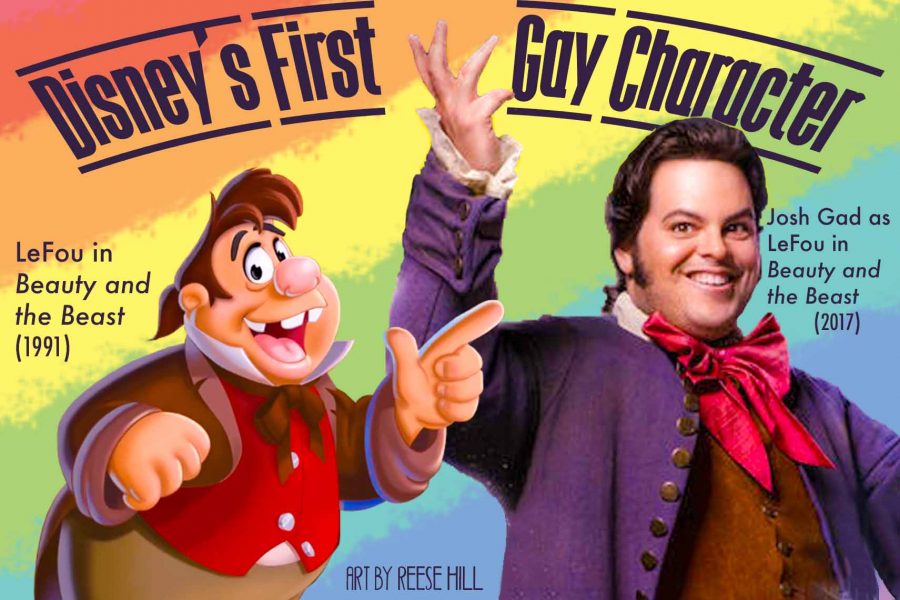Disney’s First Gay Character: What Is Representation?
We all know Disney has become increasingly progressive in the past few years with its inclusion of more diverse casts, feminist movies, and empowering messages in its films. Following Frozen, a movie which focused on platonic love saving lives over romantic relationships, and Moana, the first movie with a Polynesian princess and a non-white cast with no male love interest whatsoever, Disney’s latest reformist step has sparked revolt across every variant of opinion: in the live-action remake of Beauty and the Beast, Disney has unveiled its first openly gay character.
Unsurprisingly, this has led to loud controversy — from my mother complaining about it over dinner to the movie being banned in an Alabama drive-in theatre and in countries like Kuwait and Russia, where gay rights are next to nonexistent. However, the strongest resistance to this news came from the LGBT community itself.
This is because at first glance, Lefou is as stereotypical a gay character as they come. Lefou is the villain’s fumbling sidekick and bares the brunt of most of the movie’s jokes. He is short and stout and flamboyant and foolish. His love interest, Gaston, is the misogynistic villain of the movie and an abusive bully to both Lefou and all those around him. In the 1991 cartoon, his appearance is anything but charming. And worst of all, his name literally means “the fool.”
The whole point of LGBT inclusion is to break stereotypes rather than enforce them, but in ‘Beauty and the Beast,’ Disney seems to be doing the latter. They repeat harmful tropes the film industry has been using for decades: creating gay characters as goofy sidekicks whose only purpose is to liven up the movie, as well as the justification of abusive and manipulative relationships.
So the controversial question is this: what is and isn’t progressive representation?
“I felt really good about [Disney’s decision] at first and then I thought about it and realized that of all the characters, they picked the one that was iffy, I guess,” said Margaret Glenn ‘20. “It felt like they could be stereotyping.”
Many agreed that while Disney’s inclusion of a gay character is a great step forward, they made the wrong decision about who they used to represent the LGBT community. Several even had their own ideas as to who Disney could have chosen instead.
“I think having a gay character is a progressive choice,” said Lizzi Ayers ‘20. “But I think they could’ve picked a different character; maybe Belle’s dad.”
“I think there are other characters I would have chosen, especially because Gaston is so aggressive I don’t think that would be a very healthy relationship,” said English teacher Mandy Sotillo. “When I heard that there were going to be gay characters I thought that they were going to be talking about [Lumiere] and Cogsworth.”
But some who were originally opposed to the idea, like Glenn and myself, found our opinions had changed once we saw the remake. Lefou became a much more developed character in the live-action film than he ever was in the cartoon, and he was even given a redemption arc and a happy ending.
“[In the movie], it was very subtle and wasn’t made as big of a deal,” said Glenn. “Which I think is a very good thing because when you see other characters that are gay, it feels like they’re played up too much, like they’re trying too hard to be progressive. But [Disney] just slipped it in and it didn’t feel forced or anything.”
“Leading up to what I saw in the movie, I was just really excited,” said Ayers. “And as a member of the LGBT community, I thought it was a really big step for Disney.”
“It shows that Disney is not biased on how they believe people should actually be,” said Maureen Fesenmeyer ‘19. “I think it’s great that people are able to show what they actually love.”
In fact, this double-sided issue of Lefou’s sexuality has led to discussions about how Disney will continue their diverse inclusion in the future and if they’ll improve how they deliver it. While Lefou was a sketchy choice, many believe Disney will use him as a platform to leap off of into greater representation and equality.
“I really hope they keep adding gay characters,” said Ayers. “I think there was talk for a while about people wanting Elsa to have a girlfriend, because they kind of set it up for her to be lesbian. I think that would be great. I hope for gay kids that they can have role models for them to look up to when they’re little.”
“We definitely need a Latina princess,” said Sotillo, who has a young daughter who loves Disney princesses. “I love what they did with Moana, where there was no romance, [and] she wasn’t saved by a man. In fact, she was the one who saved the demigod in that film, so I think if they keep on that path that would be very positive.”
Progress only counts, of course, if it’s followed through. And perhaps Disney should listen to feedback from their audience to understand what proper representation really means. After all, marginalized peoples are going to have the best advice on how to encourage and preach acceptance for discriminated groups.
“I think they should add more Disney princesses of color,” said Ayers. “I think it would be cool if there were a trans character or a trans princess. It’s good to have a gay side character, but it would be even more powerful if the actual princess was.”
Thankfully, Lefou, however questionable of a decision, is a promising sign for Disney’s future films and projects. And perhaps, even, it’s a sign of optimism for the entire film industry.
“I think [we’ll see representation] outside of Disney, too,” said Sotillo. “If [they’re] paving the way it’s going to allow other films to do the same.”
